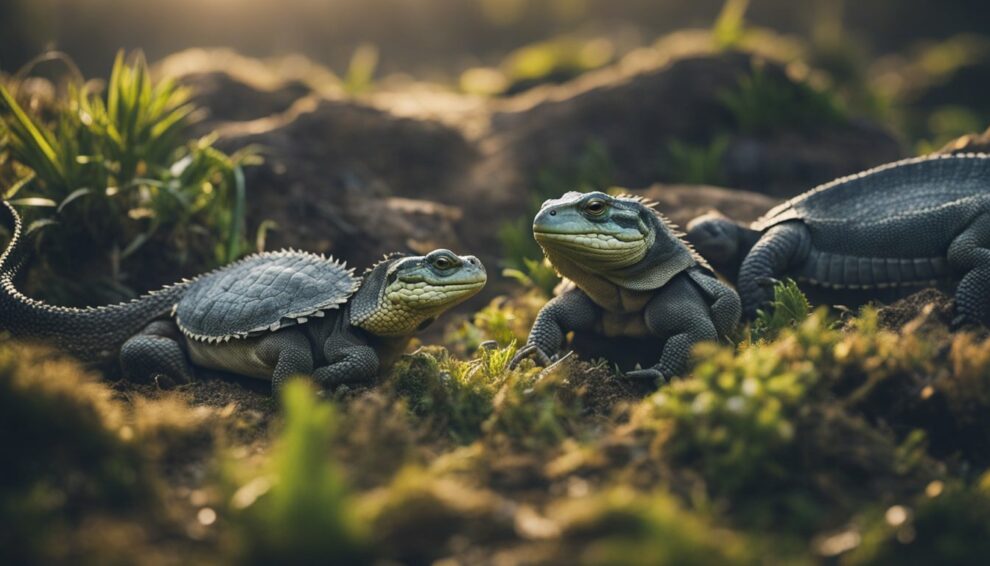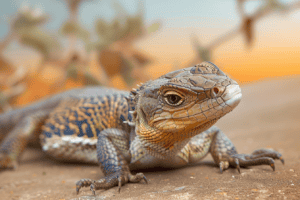Climate change is altering our planet in many ways, and its effects on reptile hibernation are particularly intriguing.
When winter arrives, some reptiles enter a long nap called hibernation to save energy during the cold months when food is scarce.
But as the Earth’s temperature changes, so do the patterns of these cold-blooded creatures’ slumbers.
Imagine being cozy in your bed and suddenly, it’s too hot to sleep — that’s a bit what these reptiles might be experiencing.

Reptiles like snakes, turtles, and lizards depend on the environment’s cues to tell them when it’s time to wake up or fall asleep for the season.
However, with the climate shifting, their traditional hibernation schedules are getting mixed up.
Warmer winters can cause reptiles to wake up too early, when there’s not enough food available, or not to hibernate at all, using up energy they can’t easily replace.
Have you ever wondered how these changes affect the reptile neighbors in your backyard or local park?
Their ability to adapt to these new patterns can make a big difference in whether they thrive or face new challenges.
Some might start their hibernation later, end it sooner, or switch locations to find a better spot to rest.
It’s like trying to find the perfect conditions for a peaceful sleepover, only the stakes are survival.
Let’s explore how these scaly friends are adapting to keep up with the times.
Understanding Reptile Hibernation

When winter approaches, some creatures find clever ways to cope with the cold.
Reptiles, unlike fuzzy bears, enter a state of deep sleep that’s quite special.
Let’s explore what this hibernation really means for our cold-blooded friends.
What Is Reptile Hibernation?
Reptile hibernation, also known as brumation, is a period of dormancy that occurs in cold-blooded animals.
During this time, reptiles slow down their metabolic processes to conserve energy when temperatures drop and food becomes scarce.
Now, you might wonder, do all reptiles hibernate the same way? Well, not quite!
Their environment and species greatly influence how they experience this snooze fest.
Some might burrow underground, others may tuck away in rock crevices, and a few even take to the water bottom to wait out the winter.
This sleepy time is not just a nap; it’s vital for their survival.
Types of Reptile Hibernation
Not all reptile hibernations are created equal. They fall into a couple of different patterns based on their habitats and needs.
-
Ectothermic Brumation: This is where the fun begins for our scaled pals.
These creatures rely on external heat sources to regulate their body temperature, so when it gets chilly outside, they have to find cozy spots to maintain their cool – literally!
This can include leaf litter, mud, or inside logs.
-
Aquatic Brumation: Then there are those who love a good swim—even in their sleep!
Aquatic reptiles like certain turtles can hibernate under water.
They slow their heart rates and absorb oxygen straight from the water through their skin, an adaptation worthy of superhero status!
Each of these hibernation types enables reptiles to survive in climates that, without this adaptation, might be a bit too frosty for comfort.
So the next time you cuddle in your warm blanket, imagine these amazing critters waiting out the winter in their own unique ways.
Isn’t nature just awesome?
Climate Change Basics

Climate change is altering our planet in many ways, impacting animals, plants, and environments across the globe.
Reptiles, with their temperature-dependent lifestyles, are facing unique challenges during their hibernation cycles as a result.
Defining Climate Change
Imagine the Earth wrapped in a giant blanket that’s getting thicker, trapping more and more heat.
Climate change refers to long-term shifts in temperatures and weather patterns, primarily caused by human activities.
Since the late 19th century, our planet’s average surface temperature has risen, leading to a host of changes in climate and weather.
Causes of Climate Change
The leading cause of this ongoing climate shift is the increase in greenhouse gas (GHG) concentrations in the Earth’s atmosphere.
These gases, such as carbon dioxide (CO2), methane (CH4), and nitrous oxide (N2O), trap heat from the sun and warm the planet.
Fossil fuel use, deforestation, and industrial processes are major contributors to GHG emissions.
Each year, human activities release over 30 billion tons of CO2 into the atmosphere, with energy production leading the charge.
Did you know that even cows play a part in climate change? They do so by producing methane during digestion, which is a potent greenhouse gas.
It’s not just about what machines emit; it’s also about the everyday processes within agriculture and nature.
Understanding these causes helps us see the bigger picture of how climate change affects all living things, including the reptiles preparing for their winter slumber.
Impacts of Climate Change on Habitats

Climate change reshapes reptiles’ environments, altering conditions critical for their survival during hibernation.
Altered Habitats and Food Sources
Reptiles rely on stable habitats and food supplies, but changing temperatures and weather patterns are transforming their homes.
For instance, warmer climates can cause the early emergence of reptiles from hibernation before sufficient food is available, leading to a mismatch in timing.
Sudden cold snaps later in the season can then catch these cold-blooded animals unprepared, possibly resulting in a decline in reptile populations.
In areas where reptiles used to thrive, increased temperatures are leading to drier conditions, reducing the availability of their prey and impacting the delicate balance of their ecosystems.
Shifting Geographic Ranges
As habitats warm, reptiles may be forced to move to cooler areas, altering their geographic ranges.
A study on North American lizards showed that some species have moved to higher elevations where temperatures are more suitable for hibernation.
However, such movements can also lead to overcrowding and increased competition in these new habitats.
Imagine common garden reptiles like the Eastern box turtle that traditionally hibernate in leaf litter and soil now having to move further north to find suitable hibernation spots because their home turf is just too hot.
This shift isn’t a leisurely stroll; it’s a survival trek, with many not making it to their new, cooler destinations.
Adapting to Change

When climates shift, reptiles must recalibrate their survival strategies.
This pivot plays out in their behavioral changes and the conservation strategies human friends employ.
Reptile Behavioral Changes
Reptiles, including turtles, snakes, and lizards, rely on the environment to regulate their body temperature.
As temperatures fluctuate, these cold-blooded animals are adjusting their hibernation patterns.
Some may enter a state of dormancy earlier than usual, while others might wake sooner if winters are milder.
Researchers have documented cases where certain reptile species modify the location of their hibernation to suit the changing temperature.
For example, the North American wood turtle has been observed seeking out south-facing banks which remain warmer, maximizing their exposure to the winter sun.
Interesting Fact: Did you know that some reptiles can adjust the timing of their hibernation up to a month in response to altered winter temperatures?
Conservation Efforts
Conservationists and scientists are taking bold steps to safeguard reptiles from the impacts of climate change.
They create artificial hibernation environments to provide stable conditions, ensuring these creatures can rest undisturbed.
Habitat protection is crucial, with targeted actions to preserve the areas where reptiles traditionally hibernate.
Strategic placement of shelters can give reptiles safe spots to hibernate, while protecting land from development maintains the natural spaces these species depend on.
Did these majestic creatures know you would help protect their winter slumbers?
By supporting conservation initiatives, habitats can be maintained, allowing reptiles to continue their timeless winter ritual amidst a changing world.
Frequently Asked Questions

Climate change is rapidly altering the ecosystems we are part of, and these shifts are having notable effects on the habits and survival of hibernating reptiles.
This segment aims to clarify some common inquiries about these changes.
How are hibernating reptile species being influenced by shifts in climate patterns?
Reptiles rely on the environment to regulate their body temperature.
As climates change, weather patterns become unpredictable, and the temperatures can either rise or drop unexpectedly.
This disrupts the circadian rhythms of reptilian species, causing them to emerge from hibernation at irregular times which may lead to food shortages or exposure to predators.
In what ways does global warming affect the sleeping cycles of reptiles?
Global warming, characterized by a general increase in temperature, can shorten the hibernation period of reptiles.
Warmer temperatures cue these cold-blooded creatures to wake up sooner than they should, potentially before the availability of adequate food supplies, thus impacting their health and survival rates.
Can you describe how temperature fluctuations due to climate change may impact reptile behavior?
Temperature variations can result in reptiles adapting unusual behaviors.
For example, if it’s too warm, they might not hibernate at all, which could lead to elevated metabolism rates and a need for more food.
If the food is not available, it could lead to starvation or increased competition with other species.
What are the potential long-term effects of climate change on the habitats of hibernating reptiles?
The homes of hibernating reptiles are threatened by climate change which can bring about alterations in vegetation and the availability of water resources.
These changes may result in habitat loss, reduce shelter options for hibernation, and ultimately decrease the population of these species.
How do warmer winters caused by climate change alter the hibernation duration of reptiles?
When winter temperatures rise, reptiles may wake up from their slumber earlier than usual.
The early awakening subjects them to a period when food is scarce, which could weaken their immunity and increase mortality.
It also has the potential to throw off the delicate balance of the ecosystems where they play crucial roles.
Why is it important to understand the impact of climate change on reptile hibernation for biodiversity conservation?
Grasping this impact is vital because reptiles are integral to the balance of natural ecosystems.
Their hibernation not only affects their survival but also the larger biodiversity mix.
By understanding these patterns, conservationists can create strategic plans to protect reptiles and by extension, preserve the intricate web of life that sustains us all.









